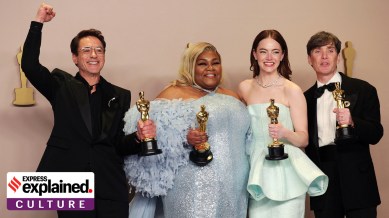However, there are many stories surrounding the name “Oscar”. Its official website states: “Officially named the Academy Award® of Merit, the statuette is better known by its nickname, Oscar, the origins of which aren’t clear.” We take a look.
The Oscars were not always the Oscars.
Held in 1927 in a 15-minute ceremony and not broadcast on any mass medium, the first ceremony was a rather plain affair.
Some weeks later, entertainment company MGM’s art director Cedric Gibbons sketched the figure of a knight gripping a sword, standing in front of a film reel. Based on this design, the present version of the trophy was born.
Bruce Davis, the Academy’s Executive Director for 20 years, wrote in his book The Academy and the Award that a need was felt for a shorter name by the mid-1930s.
The trade magazine Variety suggested calling it “the iron man” briefly but the name did not find much acceptance. “The gold man” also had a short run. “A name that undercut the pretensions of the Academy’s award would need to be found, and soon enough it was,” Davis wrote.
Story continues below this ad
“Once the name “Oscar” became established, though, the nickname lost nearly every trace of its original coating of smirk, and the adoption of similar two-syllable Christian names became the first order of business for the founders of a crowd of subsequent prizes—Emmys, Tonys, Cesars, Edgars, Clios, and more,” he added.
Why the name Oscar, though?
Davis looks at three people often at the centre of origin stories about the name Oscars: actress Bette Davis, librarian and later Academy Executive Director Margaret Herrick and Hollywood gossip columnist Sidney Skolsky.
Bette Davis
Bette Davis won the Best Actress award in 1936. She wrote in her 1962 book The Lonely Life about that moment: “I stared at the little gold-plated man in the palm of my hand. He was a Hollywood male, and, of course, epicene; but in a kind of madness his backview was the spit of my husband’s.” She was then married to Harmon Oscar Nelson.
However, Bruce Davis casts doubts on this claim, saying the name was seen used for the award at least two years before Betty Davis’s win. She later admitted, “I don’t feel my fame and fortune came from naming Oscar “Oscar.” I relinquish once and for all any claim that I was the one — so, Academy of Motion Picture Arts and Sciences, the honor is all yours.”
Margaret Herrick
Story continues below this ad
Then comes Margaret Herrick. When she worked as the first librarian at the Academy, a copy of the trophy stood on an executive’s desk and she was formally introduced to it on her first day. “She regarded it a moment. “He reminds me,” she observed, “of my Uncle Oscar.””
A newspaper columnist present there wrote in his story the next day that “Employees have affectionately dubbed their famous statuette ‘Oscar.’” This is the version of the story Davis writes in his book, as Herrick told to people.
While this event happened five years before Bette Davis’s account, Herrick was unable to prove that she did, in fact, have an uncle named Oscar. A distant relative was, however, found to have the same name. The newspaper column was also not found.
Sidney Skolsky and a fourth candidate
Finally, the Hollywood columnist Sidney Skolsky. He was apparently frustrated with the official term used to refer to the trophy – “statuette”.
Story continues below this ad
He wrote: “(The term) threw me… I’d show them, acting so high and mighty about their prize. I’d give it… a name that would erase their phony dignity. I needed the magic name fast… I remembered the vaudeville shows I’d seen. The comedians having fun with the orchestra leader in the pit would say, “Will you have a cigar, Oscar?”
The orchestra leader reached for it; the comedians backed away, making a comical remark. The audience laughed at Oscar. I started hitting the keys. During the next year of columns, whenever referring to the Academy Award, I used the word “Oscar.” In a few years, Oscar was the accepted name.”
Again, Davis writes that Skolsky was hardly the first to use the name and finds the Vaudeville inspiration dubious.
Davis offers another challenger of his own, named Eleanore Lilleberg, who never took credit for the naming herself.
Story continues below this ad
Working as a secretary and general office assistant at the Academy, she had Norwegian roots. She was born in Norway in 1871, a year before Oscar II was crowned as king of Norway and Sweden. Davis believed this could have been a source of inspiration.
Lilleberg’s brother, also an Academy member, later wrote in an unpublished autobiography that her inspiration was a Norwegian general who lived in Chicago. The trophy “stood straight and tall” and reminded him of the man.
Two other people who frequented Academy offices also gave her the credit, saying her term for it in the office eventually grew popular.
“By 1939 the organization had decided that the nickname was an asset rather than an impropriety, and E. D. Lilleberg’s contribution, though not acknowledged, was finally embraced,” Davis writes.
